By Stary Shakhtyor
On the last day of our stay, we were taken to the famous Kondong greenhouses. They are 30 kilometers north of Pyongyang and, if I understand correctly, are considered a district of Pyongyang, kind of like Zelenograd is to Moscow. Earlier this year Kim Jong-un, the Grand Marshal and Chairman of State Affairs, visited them before us, and at the last Congress of the Central Committee of the Workers’ Party of Korea, he gave this farm as an example of how to implement the 20:10 strategy. As a reminder, the Koreans are going to modernize or build new factories in 20 counties in 10 years.
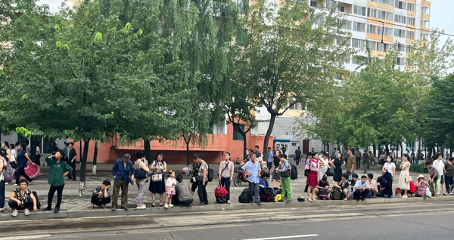
We left in the morning as the people of Pyongyang are getting ready for work. The roads and streets are filled with cars and people. There are queues for public transport at the bus stops. You can see that many people have started to work – utility workers are weeding lawns, cleaning up the dirt that has accumulated on the streets, sweeping the roads. Especially stylish look the communal workers who work near the Palace of the Sun, where the bodies of deceased leaders rest in sarcophagi. The women are wearing white shirts, bright blue trousers and panamas – our car slowed down and I took a photo.
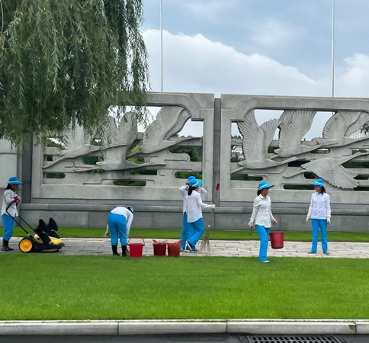
Outside the city limits, work is in full swing – peasants are working in the fields. After a certain number of kilometers, at junctions, bridges, tunnels, you can see soldiers’ posts, and in villages at crossroads – traffic policemen in white jackets, caps and ties, as if on parade. Everything is controlled. The system works perfectly.
Fields, endless, well-groomed fields, hills stretching away to the blue mountains on the horizon. After a while a perfect village appeared – typical two-story houses with green roofs. Rows of sticks appeared, with a small tree tied to each post – a fruit and berry farm. These sticks are endless, more than five minutes I was shooting from the window with cars, and they still did not end. Moreover, when rocky areas were encountered, the sticks climbed up stony hills together with the trees. Koreans squeeze everything possible and impossible out of their land, planting everything wherever they can and cannot.
Take a look at Korea’s landscape and the cultivation efforts in the following video: https://dzen.ru/video/watch/67137b2a24fe92627af5dab2?share_to=link
After the gardens we passed a post, turned off and crossed the river by a bridge. From the bridge we could see a dam with a small hydroelectric power station turbid after rainwater rushing over the dam. The DPRK makes the rivers obey, make them provide the necessary electricity.
Again, a military post, we slow down, soldiers salute. Everything here is guarded like in wartime, as if the country is waiting to be attacked. The United States and South Korea have been demonstratively conducting exercises with simulated nuclear strikes time after time.
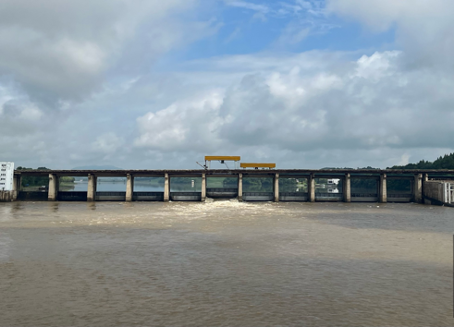
We left the forest belt for the open countryside. Outside the window, very greenhouses appeared. We are travelling the Kim Jong-un way, following footsteps hot and dear to Koreans – it was only in February that the Chairman came here. The territory and near the farm are ennobled – lawns are cut, shrubs are shaped. Everything as in paradise pleases the eye, but it is stuffy and hot.
The farm is fenced, just in case, at the entrance there is a guard – a fighter in a grey uniform and blue trousers – some new coloring. When he saw us, he put his outstretched palm to his Kim Il-sung cap with a star.
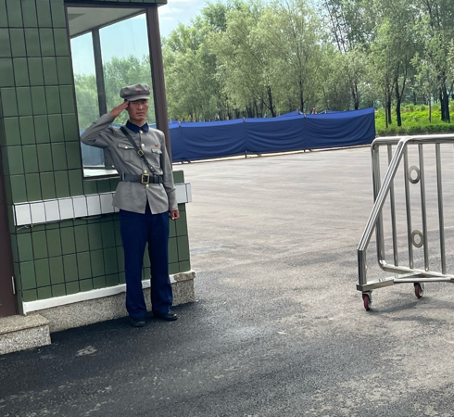
The obligatory slogan of decisive red letters was hammered into the ground. At my request, they translated it to me – “Until the end of the revolution together with the Central Committee of the Workers’ Party of Korea”.
The area of the greenhouse complex is 260 hectares, on 110 of them plants are directly cultivated – impressive. They collect 25 thousand tons a year of all kinds of vegetation. Harvests are collected continuously from a bush on 3 collections per year. Greenhouses of different types – semicircular, like spheres, or in the form of oblong hangars, or rectangular barracks. Between them are lawns with borders, shrubs and asphalt paths.
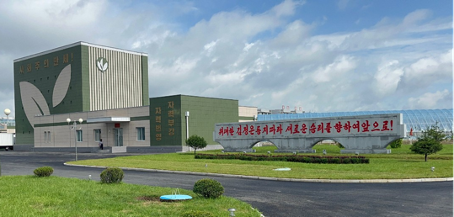
We went into a hemisphere. There were mechanical racks with shelves, and on the shelves, in a row, containers with sprouts, covered with Styrofoam with round holes. The mechanism rotated the shelves, some of them went up in a circle, others went down, and so on up and down in a circle. In this way the growing plants, arranged in a limited area, received an even amount of light. The plants are buried by their roots in nutritious perlite, not soil. No insects! No critters crawl through, no penetration, everything is sterile! The plants are clean. Mint, sorrel, lettuce and other herbs grow here in absolutely comfortable conditions.
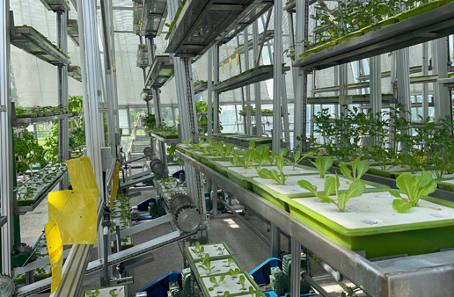
All right! That’s great. To be honest, I’m not a greenhouse expert, or rather, I’ve only seen them on TV or in magazines, but everything I see now is impressive. In general, the whole of North Korea is a country of strong impressions. A land of smiles and wonders.
We moved to the neighboring greenhouse. There are cucumbers growing and thriving there, suspended by strings. They grow all year round, both summer and winter, the right temperature is maintained here. Tubes are stuck into the ground, i.e. perlite, and a nutrient solution flows through them. It is specially designed for this crop, and one can probably say that it was developed according to the Juche method. We immediately found one such ripening Juche fruit in the ovaries of the greenhouse. There is a couple working in the aisle, a Korean man and a Korean woman, snipping off unwanted leaves from the plants. When I approached, the Korean looked away, quickly took off his cap, and bowed to me in a communist way, greeting me. I made a head bow as well. We are from the planet Russia.
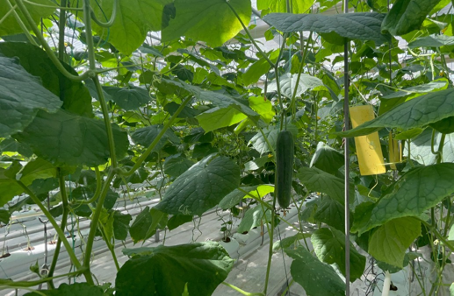
Then we went to another greenhouse, and then we visited another one. The principle is clear, the idea is grandiose. But that’s not all. They built a whole town to the greenhouses and settled there the people who work in the greenhouse. There are 1800 flats in total, so the total population is somewhere around 2200, maybe more. It’s a whole urban-type settlement! There are schools, polyclinics, a hospital where even small surgical operations can be performed. A colony! It’s like a colony on Mars! Greenhouses and houses, like in a sci-fi novel. ‘They were swarthy and black-eyed.’ There is no doubt that if the Koreans are sent to Mars, they will start building greenhouses, ploughing hills and hollows, and growing something on their own.
They said that these houses and greenhouses were built in a year – I understand that here they build everything in one year, when necessary. So, says Jong-un, this and this in a year to appear – the Koreans got together, thought about it, involved the army, worked hard, did it… Yes, but for some reason something didn’t go well with the Ryugen Hotel. Maybe someone was shot because of it… maybe they sent him to a labor camp… although what’s not a labor camp in greenhouses? I’m fantasizing, I’m fantasizing. But the pace of construction is impressive.
By the way, the intelligentsia works on public works, as it was explained to us. On the way back, our attendants told us that on Fridays they send someone from the enterprise to agricultural work, as it used to be in the USSR, like ‘for potatoes’. I remember, I remember everything, back in the U.S.S.R. I think this is more for educational purposes, what good are intellectual hands?
A glance into the greenhouses and the settelement here: https://dzen.ru/video/watch/6713dde04bc7f77f36621419?share_to=link (Video)
When we got back to Pyongyang, we were shown the metro. Well, the fact that it is clean is probably not worth repeating, but you can guess. It’s only in Western countries that the subway stinks. Of course, the Korean underground is not like the Moscow palaces buried underground. Still, no underground in the world can compare in beauty with the Moscow metro. But to say that the metro in Pyongyang is not worse than in Leningrad is quite possible. It is built, though not with Moscow, but with Petersburg pomp. Of course, there is something of our underground capital, too – Soviet mosaics and monuments in niches.
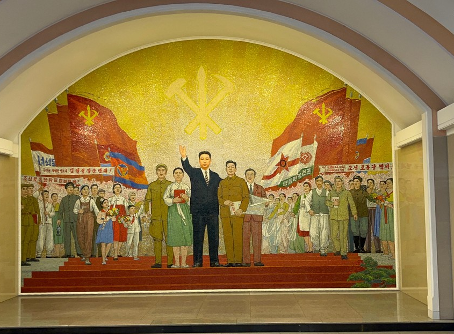
There is a difference – there are no adverts in the escalator tunnel, there are no adverts anywhere at all, and downstairs too. When you go downstairs, you look at the TV screens passing by you, with encouraging propaganda flashing across them. Downstairs – stands with newspapers. Inside the carriage there was also a TV set, and there were cartoons on when we were travelling. Puppet cartoons, of course, socialist. A bear cub with a squirrel and a hare fighting against an imperialist wolf. Very emotional, sometimes there was such a scream in the carriage.
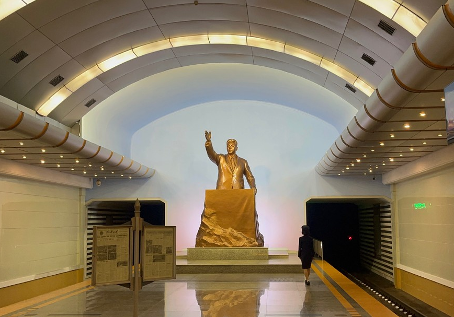
Another difference, and a beautiful one: It’s the carriage girls on the platform. They raise the red circle to get the train moving. Kind of like the signal girls who used to be up there, but who were cancelled due to the installation of traffic lights in Pyongyang. There is probably no special need for these girls, and it is possible not to use their labor, but rigid regimes always presuppose aesthetics, which in the pragmatic Western world of very conditional freedom becomes unnecessary. That’s why the subways of Western capitals stink.
Pyongyang has two underground lines, crosswise, 18 stations. No doubt more are being built. (It’s only in Ekaterinburg that two branches with many stations have been drawn on the map, and for 30 years they have existed only there.)
We went down at the station “Flame” and came out at the station “Triumph”. The names are totalitarian and lofty. I was dictated more stations at my request – Victory, Glory, Prosperity, Construction, Liberation, Golden Field. Mmm… the Golden Field…
The a trip in Pyongyang’s metro in the following video: https://dzen.ru/video/watch/6713c27acc944339e4e56518?share_to=link
At the end of the day, we always return to the Koryo Hotel. Or rather not – we always get taken back to the Koryo Inn, so at the end of my notes, I’ll talk about it too. It’s worth it – I always go back there in my thoughts.
The 44-storey Koryo Hotel is two tours, two tall towers articulated by a passage at the 30th floor level. Foreigners with whom a trusting relationship has been established are put up there, and for untested mates there is a hotel on the city island, I forget what it’s called. A foreigner is a foreign and unstable element in North Korean society, but he has a cell in the form of a cozy room in Koryo. The room has everything you need. Also, a typical capsule of a bath – toilet, and the toilet bowl of the American sample – water is poured into it after flushing – a detail for those who do not know such nuances. A new plasma TV, old Soviet-era equipment like a receiver that switches on the lights and radio.
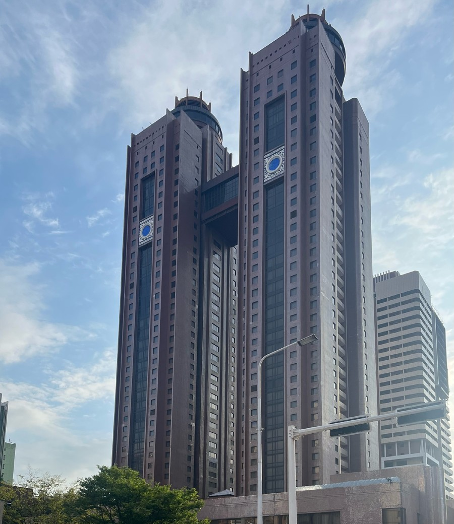
The foreigner is cared for and monitored. In the morning, they come to take a white bag with dirty clothes, and in the afternoon, they bring back clean and ironed clothes. So, you get two times to make your bed and two times to unfold the things you have scattered. Putting your room in order can be ideological. I had a stack of two Korean magazines in Russian for February and June – the cleaning lady moved them so that the February one with Kim Jong-un on the cover was on top.
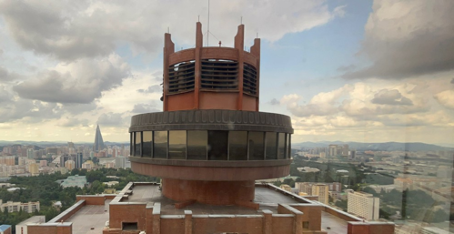
They look after you outside the room too. You are given not just the illusion of Western life, but a grotesque illusion. You feel like Mr. Twister. The lift operator says “hello” to you in Russian and runs to press the button. At the table, a waitress serves you. They feed you like a slaughterhouse. In Korea, or rather in Koryo, there is no hunger – for lunch I somehow counted eight different dishes, which were brought to our delegation in turn. Plus, ice cream. And it was like that every day. I soon gave up breakfast, preferring it to half an hour of sleep.
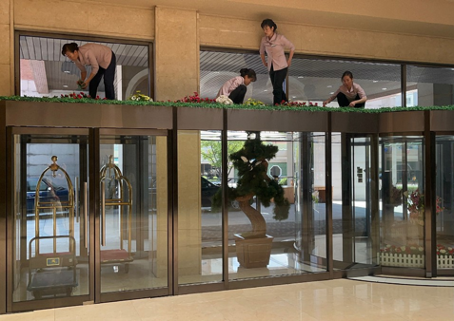
You can order additional services: downstairs there is a sauna, swimming pool, billiards. Settlement is in dollars and euros, but yuan is also accepted. There is a currency shop downstairs, like Beryozka, the assortment is small, but everything from jewelry and clothes to food and medicines is sold there. It is Korean goods that are cheap. One day I felt I was getting a cold and bought vitamin C and a pack of antibiotics just in case, and it only cost me one dollar. From clothes I tried to buy a white shirt with cropped sleeves, but there was no size for me, even XXL Korean didn’t fit. Koreans don’t assume tall and wide people like me. I bought a white t-shirt with a flag and the words “Meet me in Pyongyang.” We will.
But the large assortment of Korean souvenirs and Juche books is on the first floor. Here you can buy everything from quotes from the great leaders to their writings. As well as stamps, flags, magnets and other touristy stuff. Calendars, figurines.
We were advised not to go anywhere in Koryo without an escort, so as not to cause problems. In principle, you can live in Koryo all your life, provided, of course, that Koreans want to. The hotel is half-empty, I think, apart from foreign guests, there are departmental flats of top party workers and servants. By the way, the government quarter is not far from Koryo, two hundred meters down the street from the railway station.
Ordinary Koreans can also become guests of Koryo. On one of the days of our stay, heroic helicopter pilots who evacuated residents from flooded areas were settled there. Moreover, they settled them with their families, wives and children, everything is total in North Korea.
Inside the Koryo Hotel: https://dzen.ru/video/watch/6713d70808187127a53ea4dc?share_to=link (Video)
Yes, Koryo’s biggest attraction is the 44th floor round towers. One of them houses a bar-restaurant with a circular view. Moreover, the platform slowly rotates and having a drink, in one evening (or day – who leads what way of life), you can see the whole Pyongyang several times without getting up from the chair. Or rather, not quite all of it – the views of the government quarter are hidden by shutters.
There are two bars on the first floor, there are two bars on the ground floor. If you sit in them until morning and discuss Juche ideas drunkenly, you will be served until the end, even if you don’t discuss Juche ideas. You could say that these bars are open 24 hours a day. The Maltese ambassador died in one of them. To die in the Koryo in Pyongyang, North Korea… Not the worst death.
The End.
This article was previously published in Russian here. Translation to English by UWI.













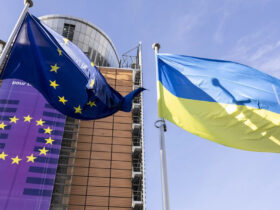
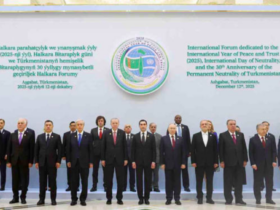
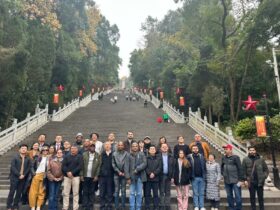

Leave a Reply